Depwade, Norfolk
Up to 1834
A paliamentary report of 1777 recorded parish workhouses in operation at Billingford (for up to 6 inmates), Dickleborough (60), Diss (5), Gissing (60), Pulham—St Mary Magdalen (40), Redenhall with Harleston (45), and Scole alias Osmondeston (10).
According to White's Norfolk Directory of 1836, the parish workhouse at Diss was built in 1730. Forncett St Peter also had a parish workhouse operating in 1836.
After 1834
Depwade Poor Law Union was formed on 14th April 1836. Its operation was overseen by an elected Board of Guardians, 53 in number, representing its 43 constituent parishes as listed below (figures in brackets indicate numbers of Guardians if more than one):
County of Norfolk:
Alburgh, Ashwellthorpe, Aslacton, Billingford, Brockdish, Bunwell (2), Burston, Carleton Rode (2), Denton, Dickleburgh, Diss (5), Earsham, Forncett St Mary, Forncett St Peter, Fritton, Fundenhall, Gissing, Hapton, Hardwick, Hempnall (2), Morning Thorpe [Morningthorpe], Moulton St Michael, Needham, Pulham St Mary Virgin, Pulham St Mary Magdalen (2), Redenhall with Harleston (3), Rushall, Scole with Thorpe Parva and Frenze, Shelton, Shimpling,
Starston, Long Stratton St Mary, Stratton St Michael, Tacolneston, Tasburgh, Tharston, Thelveton, Thorpe Abbotts, Tibenham, Tivetshall St Margaret's, Tivetshall St Mary, Wacton Magna, Wortwell.
Later Additions (all from 1902): Bressingham, Fersfield, Roydon, Shelfanger, Winfarthing.
The population falling within the Union at the 1831 census had been 24,768 with parishes ranging in size from Morningthorpe (population 164) to Diss (2,934). The average annual poor-rate expenditure for the period 1833-35 had been £24,008 or 19s.5d. per head of the population.
A new Depwade Union workhouse was erected in 1836 at Pulham Market. The Poor Law Commissioners authorised an expenditure of £8,240 on construction of the building which was intended to accommodate up to 400 inmates. It designed by William Thorold who was also the architect of workhouses for the Guiltcross, Thetford, and Walsingham Unions. His design for Depwade was based on Sampson Kempthorne's model cruciform plan published by the Poor Law Commissioners in 1835. However, the outer buildings at Depwade gave the workhouse an octagonal rather than the more usual square perimeter. The site layout is shown on the 1905 map below.
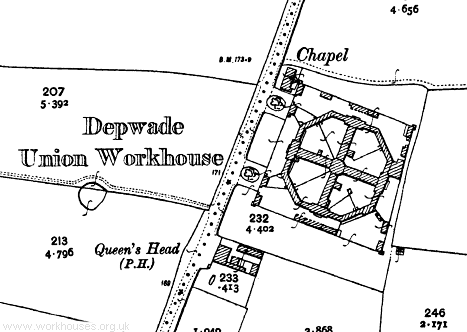
Depwade workhouse site, 1905.

Depwade from the north-west, 2000.
© Peter Higginbotham.
The entrance range at the west contained the porter's lodge, board-room, offices and so on. To the rear, radiating from the central supervisory hub, were four accommodation wings for the various classes of inmate (male/female, infirm/able-bodied etc.).

Depwade workhouse from the west, 2000.
© Peter Higginbotham.
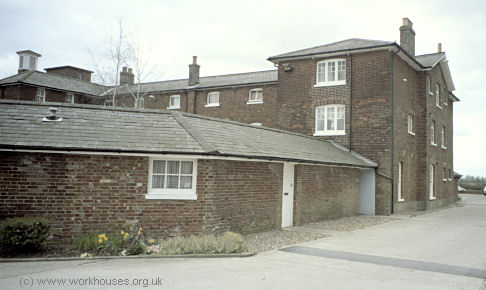
Depwade perimeter from the south-west, 2000.
© Peter Higginbotham.
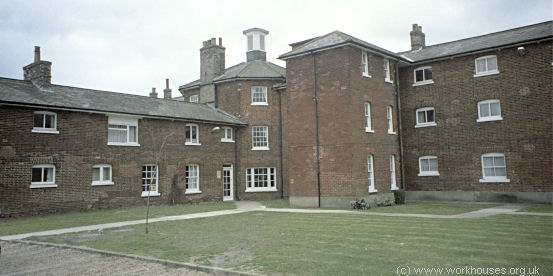
Depwade central hub from the south-west, 2000.
© Peter Higginbotham.
A chapel was added at the north-west of the site.
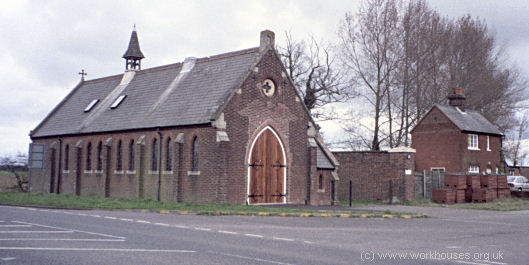
Depwade chapel from the south-west, 2000.
© Peter Higginbotham.
In 1844, an attempt were made to burn down Depwade workhouse as a result of unrest caused by the unpopular "ticket" system. Unemployed labourers were given a ticket to take round local employers. If no work was available, the employer would sign the ticket to that effect. Weekly poor relief would only be given to those submitting properly completed tickets.
After 1930, control of the Depwade workhouse site passed to the local authority and it became Depwade Public Assistance Institution. From 1948 to 1955 it was known as Hill House Hospital, and then as Hill House County Home. Following its closure, it was used for a period as a hotel called The Beadle. The building, now known as Hillcrest Court, has been converted to residential use.
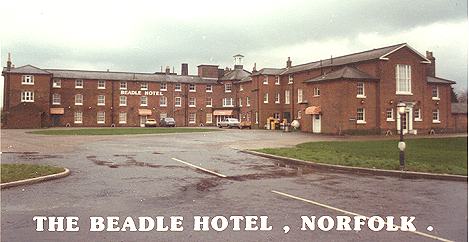
The Beadle Hotel, Pulham Market.
Children's Home
The Depwade Union operated a children's home at 'Briardale' in Long Stratton. In 1924, it could accommodate 14 children who were in the care of the superintendent Miss M.K. Batley. The property is now a private residence.
Staff
Inmates
Records
Note: many repositories impose a closure period of up to 100 years for records identifying individuals. Before travelling a long distance, always check that the records you want to consult will be available.
- Norfolk Record Office, The Archive Centre, Martineau Lane, Norwich NR1 2DQ. Holdings include: Guardians' minute books (1836-1930, with gaps); Ledgers (1836-1930, with gaps); Admissions and discharges (1900-32, with gaps); Births (1836-66); Baptisms (1859-1959); Offences and punishments (1915-30); Register of mechanical restraint (1895-1917); Lunatics' medical certificates (1878-1915); etc.
Bibliography
Links
- None.
Acknowledgment
- Thanks to Dick Johns for the picture of the Beadle Hotel.
Unless otherwise indicated, this page () is copyright Peter Higginbotham. Contents may not be reproduced without permission.


